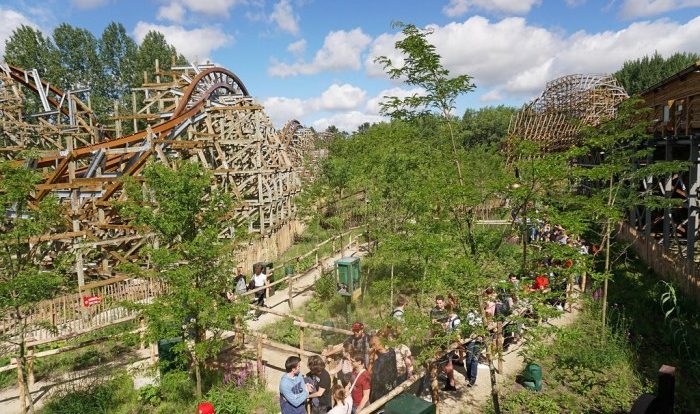What is the Cordova Rebellion? It’s a fascinating tale of historical strife and rebellion that unfolded in the heart of a turbulent region. The rebellion, driven by a complex interplay of political, social, and economic factors, left an enduring mark on the region’s history.
The Cordova Rebellion erupted amidst a backdrop of simmering tensions and discontent. The region had long been a crossroads of cultures and empires, each leaving its imprint on the local population. As political and economic conditions deteriorated, the people grew restless, their grievances finding expression in the form of the Cordova Rebellion.
Historical Context of the Cordova Rebellion
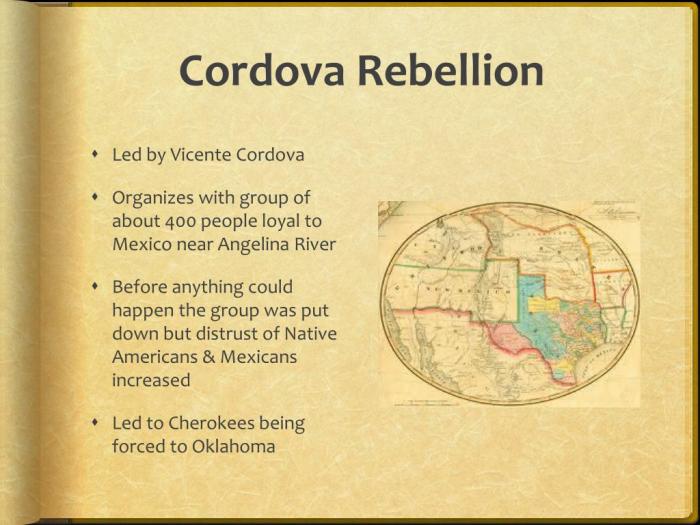
The Cordova Rebellion, which erupted in 1836, was a significant event in the history of Mexico. The rebellion unfolded in the province of Cordova, which encompasses the present-day state of Veracruz. This region had a long history of political and social unrest, fueled by a combination of factors.
The political landscape of Cordova was dominated by the conservative elite, who held significant power and influence. This elite was closely aligned with the central government in Mexico City and supported the policies of President Antonio López de Santa Anna.
However, many residents of Cordova resented the conservative elite’s dominance and the policies imposed by the central government.
Socio-economic Conditions
In addition to political grievances, the Cordova Rebellion was also driven by socio-economic factors. The region was plagued by poverty and inequality, with a large gap between the wealthy elite and the majority of the population. The peasantry, who constituted the majority of the population, suffered from high taxes, forced labor, and a lack of land ownership.
Motivations and Goals
The motivations of the rebels were multifaceted. They sought to overthrow the conservative elite and establish a more democratic and egalitarian society. The rebels also aimed to gain greater autonomy from the central government and to address the socio-economic grievances of the peasantry.
The Cordova Rebellion, a revolt against Spanish rule in the Philippines, was a pivotal event in the country’s history. Like the case of Bayliner Marine Corp. v. Crow , it showcased the Filipinos’ struggle for independence and their resilience in the face of adversity.
The rebellion, which took place in the late 1800s, aimed to overthrow Spanish colonial rule and establish a sovereign Filipino government.
Key Events and Figures
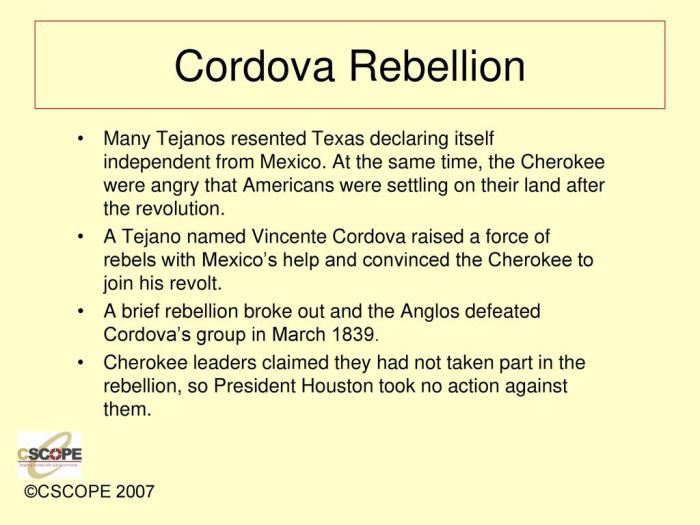
The Cordova Rebellion unfolded through a series of significant events:
- January 1851:The rebellion began with a revolt by General Jose Maria Flores in Guadalajara.
- February 1851:General Antonio Lopez de Santa Anna, the former president of Mexico, returned from exile and joined the rebellion.
- March 1851:The rebels captured the city of Puebla.
- April 1851:The Mexican government sent an army to suppress the rebellion.
- May 1851:The rebels were defeated at the Battle of Calpulalpan.
- June 1851:Santa Anna was captured and the rebellion was crushed.
Key figures involved in the Cordova Rebellion included:
- General Jose Maria Flores:A Mexican general who led the initial revolt.
- General Antonio Lopez de Santa Anna:A former president of Mexico who joined the rebellion.
- President Mariano Arista:The president of Mexico during the rebellion.
- General Manuel Doblado:A Mexican general who led the government forces that defeated the rebellion.
The strategies employed by the rebels included guerilla warfare and hit-and-run tactics. The Mexican government used conventional military tactics to suppress the rebellion.
Impact and Legacy of the Cordova Rebellion
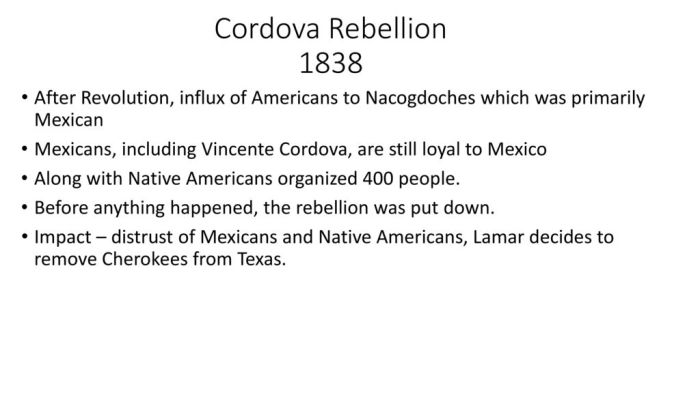
The Cordova Rebellion had far-reaching consequences, both immediate and long-term. It not only shook the political landscape of the region but also influenced subsequent events and movements.
Immediate Consequences
In the immediate aftermath of the rebellion, the Spanish authorities responded with swift and brutal force. The leaders of the rebellion were executed, and many of their followers were imprisoned or exiled. The city of Cordova was heavily damaged, and its economy was severely disrupted.
Long-Term Consequences
The long-term consequences of the Cordova Rebellion were equally significant. The rebellion demonstrated the growing discontent among the Muslim population of Al-Andalus. It also showed that the Spanish authorities were willing to use force to suppress dissent. This led to a gradual erosion of trust between the two communities.
Influence on Subsequent Events
The Cordova Rebellion had a profound influence on subsequent events in Al-Andalus. It helped to inspire other rebellions, including the larger and more successful Umayyad Caliphate. It also contributed to the growing sense of Muslim identity in the region.
Comparative Analysis: What Is The Cordova Rebellion
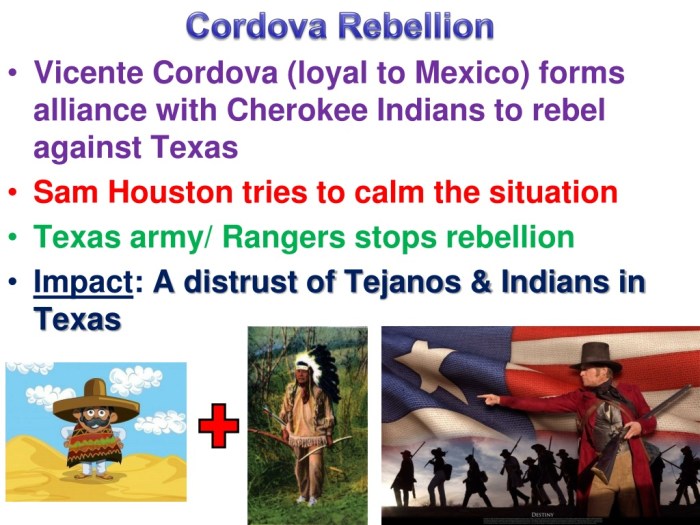
The Cordova Rebellion shares similarities and contrasts with other historical uprisings. Its causes, goals, and outcomes provide valuable lessons for understanding social movements and the dynamics of rebellion.
Causes and Goals
Like many uprisings, the Cordova Rebellion was fueled by economic grievances, political oppression, and social inequality. The imposition of heavy taxes, the decline of traditional industries, and the erosion of local autonomy sparked widespread discontent. Similar economic factors have been observed in other rebellions, such as the French Revolution and the American Civil War.
However, the specific goals of the Cordova Rebellion were unique. The rebels aimed not only to overthrow the Spanish colonial government but also to establish an independent Muslim state. This religious and political dimension distinguished the rebellion from many other uprisings that focused primarily on economic or political demands.
Outcomes and Lessons, What is the cordova rebellion
The Cordova Rebellion ultimately failed to achieve its goals. The Spanish government ruthlessly suppressed the uprising, leading to the deaths of thousands of rebels. The rebellion’s failure highlights the challenges faced by movements that seek to overthrow established powers.
Nonetheless, the Cordova Rebellion offers valuable lessons for understanding the dynamics of rebellion. It demonstrates the importance of unity, organization, and a clear set of goals. It also shows that even unsuccessful uprisings can have a lasting impact by inspiring future movements and shaping the political landscape.
FAQ
Who were the key figures involved in the Cordova Rebellion?
The rebellion was led by a diverse group of individuals, including political leaders, religious figures, and military commanders. Some of the most notable figures include Abd al-Rahman I, Yusuf al-Fihri, and al-Mughira ibn Abd al-Rahman al-Thaqafi.
What were the causes of the Cordova Rebellion?
The rebellion was sparked by a combination of political, social, and economic grievances. The oppressive rule of the Umayyad dynasty, coupled with rising taxes and economic inequality, created a fertile ground for discontent.
What were the consequences of the Cordova Rebellion?
The rebellion had a profound impact on the region. It led to the overthrow of the Umayyad dynasty and the establishment of the Abbasid dynasty. The rebellion also contributed to the rise of al-Andalus as a major center of Islamic culture and learning.

